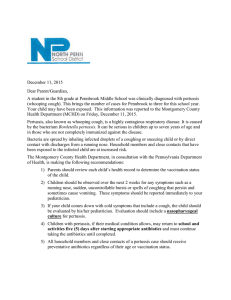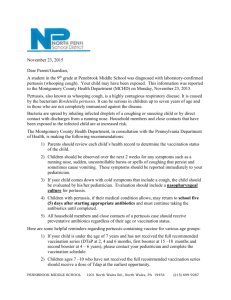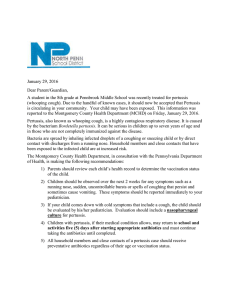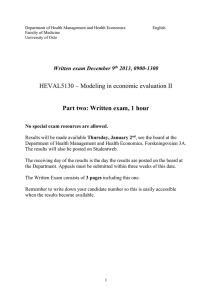Pathogen adaptation under imperfect vaccination: implications for pertussis
advertisement
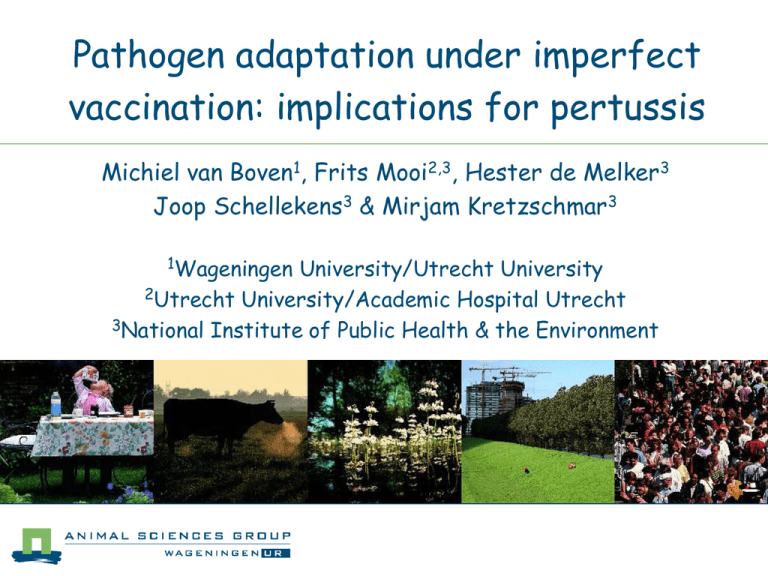
Pathogen adaptation under imperfect vaccination: implications for pertussis Michiel van Boven1, Frits Mooi2,3, Hester de Melker3 Joop Schellekens3 & Mirjam Kretzschmar3 1Wageningen University/Utrecht University 2Utrecht University/Academic Hospital Utrecht 3National Institute of Public Health & the Environment Pertussis, basic facts gram-negative bacterium first described: 1540 ! first isolated: 1906 by Bordet and Gengou main species in the genus Bordetella: B. pertussis, B. parapertussis, and B. bronchiseptica B. pertussis and B. parapertussis : mostly human B. bronchiseptica : dogs, pigs, sheep Bp and Bpp : limited survival outside the host Bb : prolonged starvation resistance Bp and Bpp infections: severe in unvaccinated infants, usually mild in adolescents and adults Pertussis vaccination before 1940: a leading cause of infant death nowadays: very low mortality rates in developed countries Dutch vaccination program: started in 1953 vaccine: killed whole-cell (Tohama) vaccination coverage: ~96% up to 2002: vaccination at age 3,4,5, and 11 months since 2002: vaccination at age 2,3,4, and 10 months since 2002: booster with subunit vaccine at 4 years 2006: replacement of whole-cell vaccine by subunit vaccine subunit vaccines: 1-5 components (e.g., ptx, pertactin, fha) -1 number of cases (month ) Pertussis trend in the Netherlands 1000 800 600 400 200 0 1/1990 1/1992 1/1994 1/1996 date 1/1998 1/2000 1/2002 Age distribution of cases before and after 1996 Distribution of cases by vaccination status Virulence genes of B. pertussis Phase modulation in the bordetellae Questions What is the contribution of circulation in unvaccinated infants to the overall circulation of pertussis? How does the infection incidence depend on period of immunity after vaccination or infection? How will the pathogen population evolve in response to vaccination? Model structure 1-p p g 1h V I1 gVh V S2 S1 a1 g2 h I2 a2 R Central idea: there is a difference between infection in immunologically naïve individuals (‘primary infection’) and infection in individuals whose immune system has been primed (‘secondary infection’) Model parameters Population dynamical analysis: invasion f 1g 1 σV f 2 g 2 Rp 1 - p p α1 μ σV μ α 2 μ herd immunity cannot always be achieved (McLean and others) f 2 g 2 σV μ the reproduction ratio increases with p if f 1g1 σV for the default parameter values, Rp increases with p if secondary infections are 7% more transmissible than primary infections Population dynamical analysis: endemicity Evolutionary adaptation Adaptation of B. pertussis to vaccination occurs in two ways: (1) the pathogen population may evolve to become polymorphic (2) the pathogen may evolve higher or lower levels of virulence gene expression Scenarios 1. B. pertussis can increase (or decrease) its efficiency in immunologically naïve individuals by increasing (decreasing) the expression of virulence genes. On the other hand, increased expression of virulence genes results in a stronger immune response in primed individuals. 2. B. pertussis can evolve to circumvent the immunity induced by vaccination. However, strains that circumvent the vaccination induced immune response have reduced fitness. Evolutionary invasion analysis fitness measure: the growth rate λ(y,x) of a mutant strain characterized by a variable y in a resident pathogen population characterized by a variable x the selection gradient: ESS condition: maximum condition: convergence condition: 1. virulence gene expression In the first example, the parameters f1 and f2 are molded by selection. For this scenario, the ESS condition reads S1 f1 df 2 df 1 f1 f1 S2 f1 gVV f1 1. virulence gene expression 1. virulence gene expression trade-off: f 2 250 1 f 1 2 250 2. immune evasion In this example, the parameters σV and α are supposed to be molded by selection, and the ESS condition reads dα dgV f2V gV f2 gV gV μ p μ σV gV h gV 2. immune evasion Suppose that a resident strain is present that cannot infect individuals in class V (gv=0) The infectious period of the resident strain is 1 365 14.6 days. α μ A mutant strain that is fully able to infect individuals in class V (i.e. g’v=0) can invade if its infectious period is 1 not shorter than 365 13.1 days. α μ Δα If the period of protection after vaccination is ten years (instead of five), the mutant can invade the infectious 1 period is not shorter than 365 11.9 days. α μ Δα Pathogen adaptation: summary of results For realistic parameter values primary susceptibles constitute only a small fraction of the population, while secondary susceptibles abound. Consequently, pertussis circulation depends mainly on (unnoticed) infections in children, adolescents and adults. The pathogen is more likely to adapt to efficiently exploit secondary susceptibles than to efficiently exploit primary susceptibles. Pertussis strains that evade the immunity induced by vaccination can only invade if they incur no or a modest fitness cost. Tests and open questions How long does immunity, against infection and against disease, last after infection and vaccination? Are there systematic differences between strains found in countries with high vaccination coverage and strains found in countries with low vaccination coverage? The optimal amount of antiviral control Michiel van Boven1, Don Klinkenberg1, Franjo Weissing2, Hans Heesterbeek1 1Faculty of Veterinary Medicine, Utrecht University 2Theoretical Biology, University of Groningen Main question: What is the optimal amount of costly (i.e. potentially lethal) antiviral therapy when faced with a virulent pathogen that can kill the host? Two perspectives the public health officer: maximize the performance of the population the individual: maximize your own performance given the actions of those around you Objective functions life expectancy, L(y,x) probability to be alive after T years, L(y,x,T) perceived risk, L(y, I(x), V(x)) Model structure μ : background mortality ρ : recovery rate γ : antivirals induced mortality ν : antiviral control rate α : infection induced mortality σ: non-compliance rate : force of infection 1. Life expectancy at the endemic equilibrium pathogen absent: no antiviral control: no individual differences: rare type νy in a resident population νx : Endemic pathogens, life expectancy as objective function Endemic pathogens, life expectancy as objective function Endemic pathogens, limited time horizon Endemic pathogens, limited time horizon Outbreak situations, limited time horizon ?
